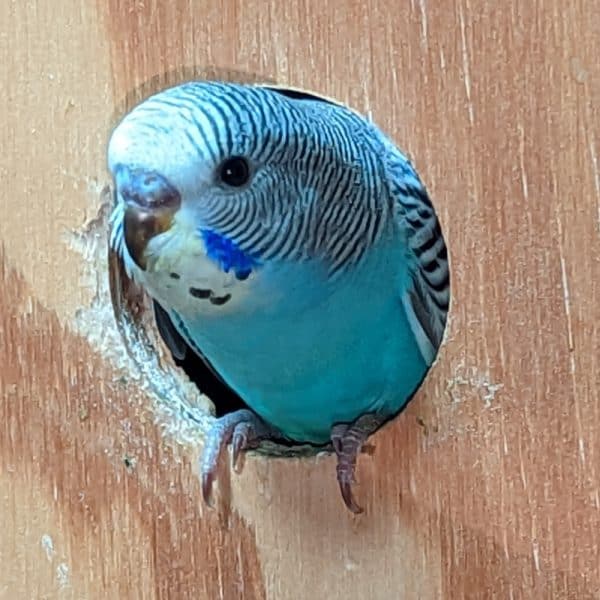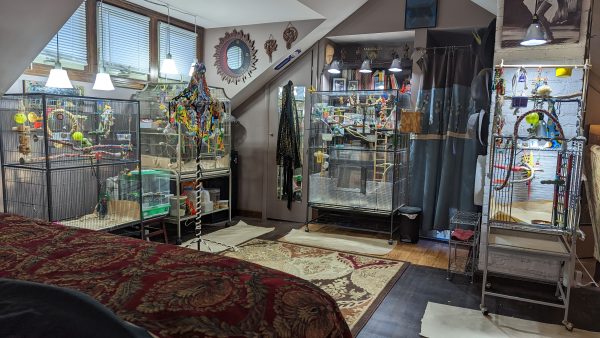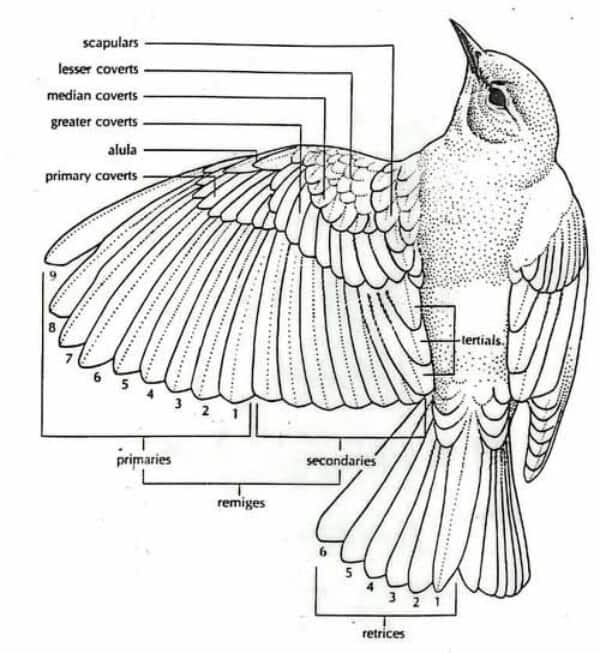
What We’re Doing to Help Smoke Our Budgie With a Broken Wing
Last Updated on by Mitch Rezman
We take these little feathered angels in. They are not placed in isolation, just Gen-Pop.
Their quality of life is second to none.
The freshest commercially prepared bird foods.
Crisp kale chopped with veggies, and fruit served fresh every morning.
The Prevue F50 serves as a spacious environment for birds and accessories.
They come, some pass, others are replaced by a new generation.

About a year ago we needed to reclaim 20 or so square feet in our “showroom.”
Crazy bird people that we are the decision to bring the big birdcage upstairs was duck soup.
11 birds in 4 cages reside 8 feet from the foot of my bed.

Three juvenile budgies now reside in the big aviary, aptly named “123” for all of them because we never named them and there are three of them and way too hard.
Unfortunately, the stress on Mom was too much and we lost her not long after the first bird started to fledge.
They live a happy carefree life and enjoy an hour or two a day of out-of-the-cage time.
Not surprisingly the 123’s and Dad take advantage of the open airspace but the others enjoy the comfort of their luxurious surroundings.
Our daily feeding routine for the budgies involves the 3 partially filled Tweaky clean feeders, then at the end of the day, we empty them into a blue glass pie plate on the bottom of the cage for a little more foraging.
Multiple Birds demand multiple feeders which avoids arguments around the dinner table. Budgies are ground feeders which is why we keep the glass plate at the bottom of the cage filled with yesterday’s seed (Catherine’s special blend) most of which Is still edible.
At 8:00 every evening all the birds get their “nummies”.
Keto the ringneck and Chili the Quaker get small chunks of Lafebers Avicakes while the budgies and Barney the cockatiel get millet.
Barney’s millet nummy is served in a small deep dish to keep the mess down because Millet hulls defy gravity.
I’ll then throw a few Millet sprigs into the glass plate on the bottom of the budgie aviary.
The three parrot cages have paper on top of their grates. I usually stack it two to three high so I just have to pull the soiled top sheet every day so the cage is look relatively nice.
Because the budgies would constantly chew up the paper making it useless we put the paper underneath the grate on top of the tray.
One evening I heard a “ thunk.” there was smoke in the Blue Plate special munching on millet.
I didn’t think much of it at the moment but it happened again the next night.
Smoke could not fly because his right wing had been broken, I could clearly see that.
I made a point of watching his movements over the next few days and he navigated the cage with ease and for whatever reason, rather than climbing to the lowest branch just a few inches over the plate he would drop down to access the millet.
We decided to take no action because he appeared to be doing well.
Upon waking up a couple of weeks ago I know his blood on a couple of the perches and could see that smoke was either plucking at his feathers or was getting attacked by the others for being weak.
There was blood on his secondaries and tertials (feathers) think of a human shoulder if you will.

My educated guess was he was picking at the pain.
We placed him in our standby hospital cage that had a heated platform and a small wood perch for sick birds as this was not our first Birdie Rodeo.
The hospital cage was set on a small stool between Keto and Chili’s cage.
I misted Smoke with wound care to help with the healing, knowing he was still hurting.
We put a towel over the cage to keep it clean because the other birds dropped junk down over it but after a couple of days Catherine made the observation that “Smoke looked depressed.”
Two problems needed to be solved, Smoke’s physical pain and mental anguish from being separated from his flock.
The Separation was an easy fix, note the video below.
Tour of the connected hospital birdcage ~ Video
I hooked the hospital cage onto the side of the big aviary so that Smoke could see everybody and everybody could see Smoke while still keeping him isolated.
Prior to placing him back in the hospital cage which had been repositioned we laid him out on a towel and did a severe wing clip so he wouldn’t be dragging the weight of feathers around.
That wore him out so I placed him on my bare chest, lay down on the bed, and stroked his head and body, I could tell he enjoyed that.
He was also in a molt so I had to be extremely careful not to cut into any blood feathers which I managed to avoid but it looked sloppy.
That was the best I could do.
Knowing an analgesic could reduce the pain and possibly stop the plucking after a few minutes of research Catherine found the recipe of five regular aspirins (325 mg each) dissolved into a gallon of water.
She split the recipe in half and did two and a half aspirin tablets into half a gallon of water.
It worked! We saw no more blood so we knew the plucking had stopped.
About four or five days later just letting the little guy rest I decided to take him out and clean up some of the feathers so they wouldn’t irritate him and perhaps trigger more self-destructive behavior.
Then before putting them back in the hospital cage, I put him on a perch in the big aviary. He fell off and struggled to regain his footing so he’s back in the hospital cage.
Although he looks weary a lot of the time, he’s still able to get around the cage.
He shares his time between the heated flat perch, an added Booda rope perch, and the small JW Pet wood perch.
Calories help to heal so he gets lots of spray millet.
I recently added a small food cup where I place the budgies chopped veggies with egg food sprinkled atop the nutritious (kale-based) veggie mixture.
Smoke came to us while we were here in Indiana so he’s been around at least a couple of years but was still downstairs for his admission.
I watch him most of the day as he lives across from my home office desk. He eats throughout the diurnal course.
When he ceases to eat it will be decision-making time.
I know some are asking rhetorically, “Why not take him to the vet?”
Having lived around birds and avian veterinarians for over 2 decades, my decision was based on potential outcomes.
Setting money aside, the only course of action a vet can really take is to amputate the wing.
Smoke is only 25 grams, he’s weak, he’s lost blood and the chances of making it through anesthesia, surgery, and recovery would be slim at best.
So I keep the heated platform and the rest of the cage clean.
He gets fresh food, millet, and aspirin water throughout the day.
Thus we do what we advocate, which is our corporate motto.
“We took the birds out of the sky, it is our responsibility to provide the best care possible.” Catherine Tobsing, President Windy City Parrot, Inc.
Written by Mitch Rezman
Approved by Catherine Tobsing
Author Profile
Latest entries
 The Traveling BirdJune 26, 2025Can You Name 5 Parrot Species That Are Living Wild in the USA?
The Traveling BirdJune 26, 2025Can You Name 5 Parrot Species That Are Living Wild in the USA? Bird BehaviorJune 26, 2025How is it Parrots Are Problem Solvers Social Animals and Even Use Tools?
Bird BehaviorJune 26, 2025How is it Parrots Are Problem Solvers Social Animals and Even Use Tools? Bird & Parrot AnatomyJune 25, 2025How a Tiny Chemical Modification Makes Parrots Nature’s Living Paintings
Bird & Parrot AnatomyJune 25, 2025How a Tiny Chemical Modification Makes Parrots Nature’s Living Paintings PigeonsJune 20, 2025How Do Parrots Thrive in Cities Outside Their Native Habitats?
PigeonsJune 20, 2025How Do Parrots Thrive in Cities Outside Their Native Habitats?


